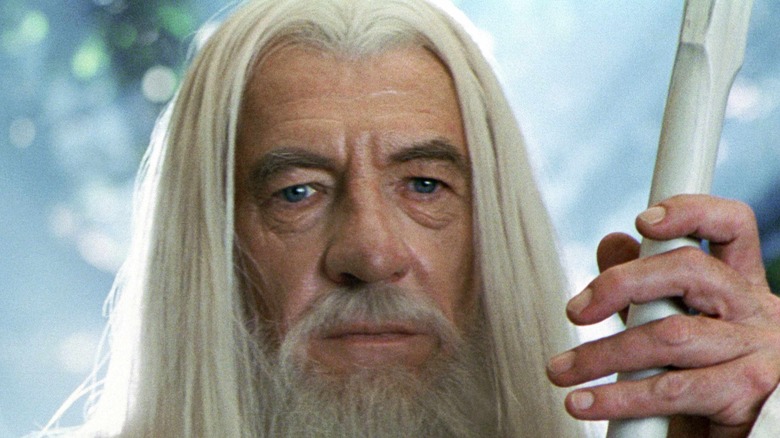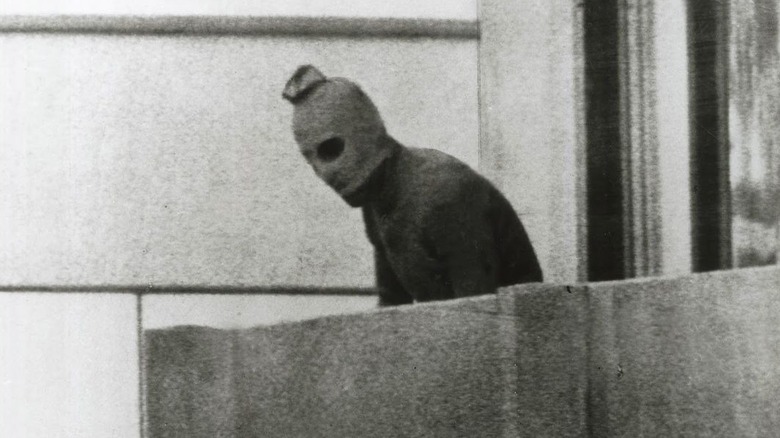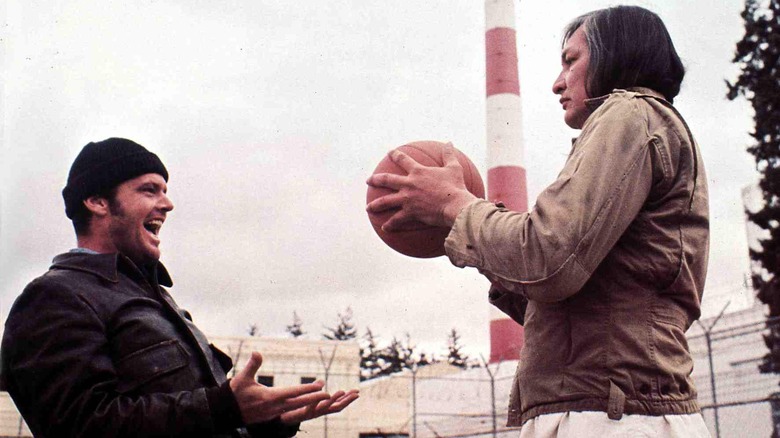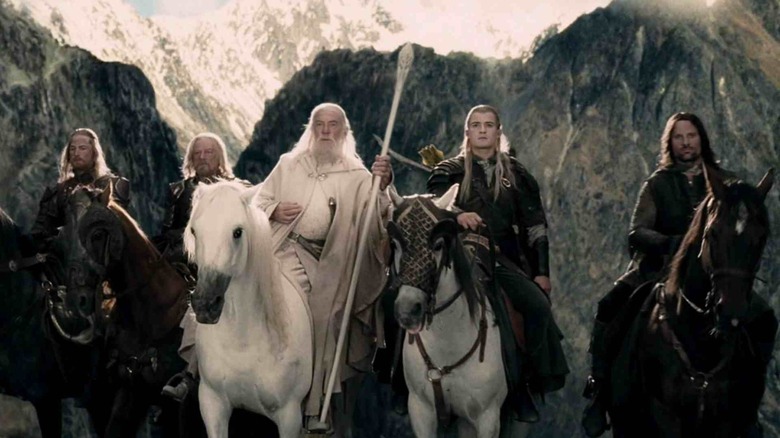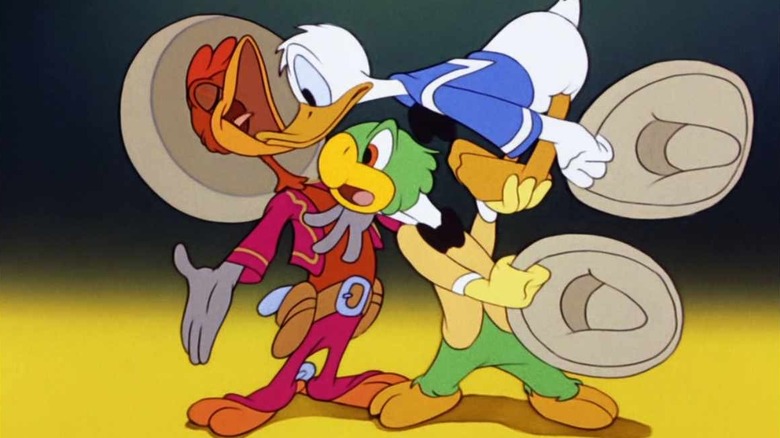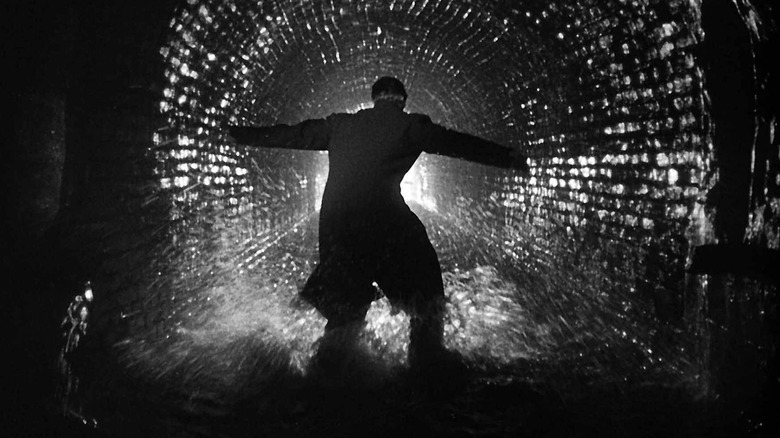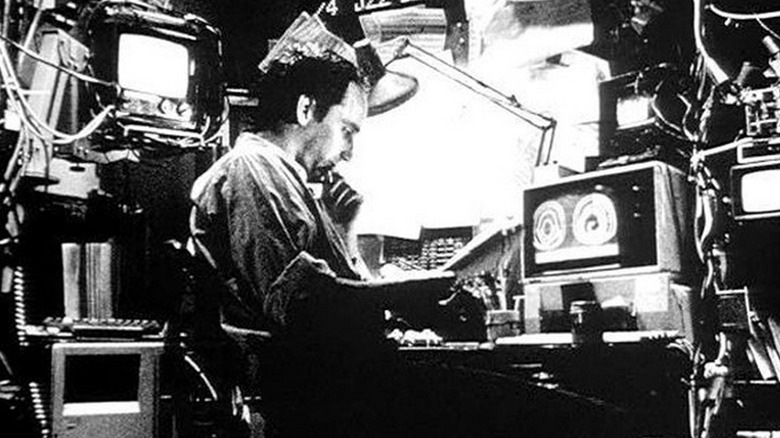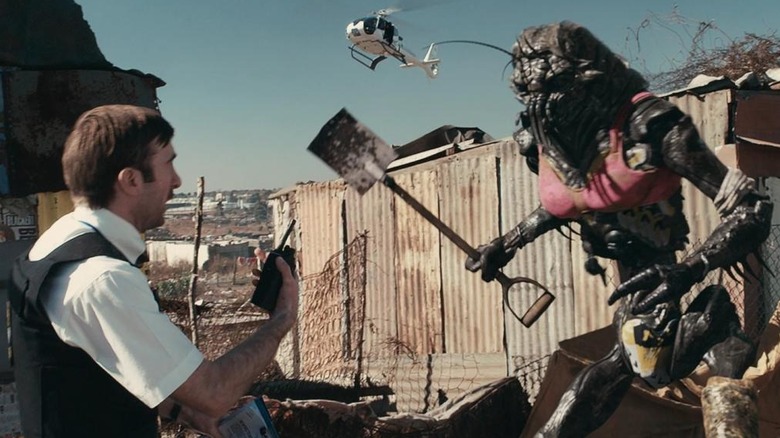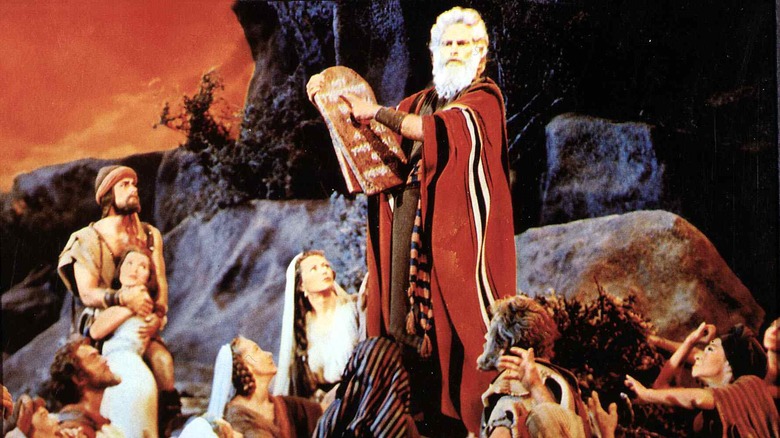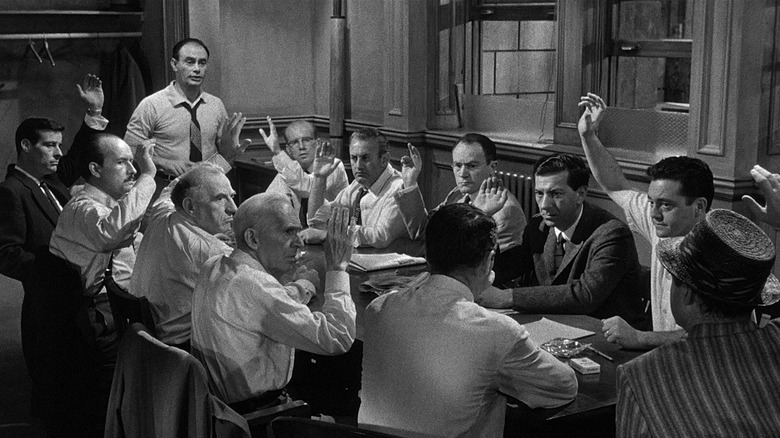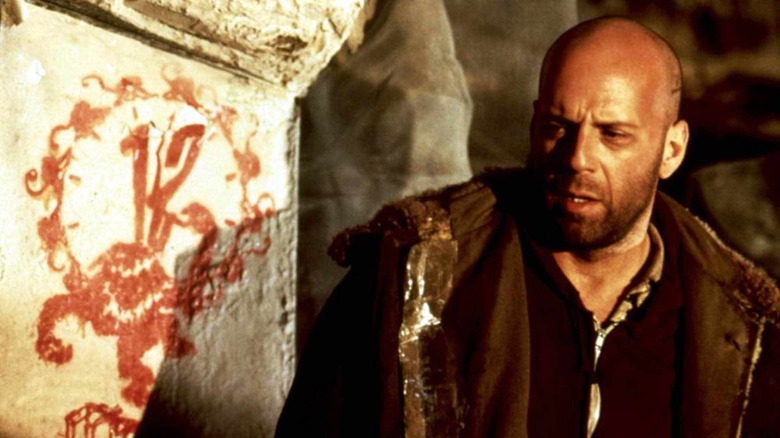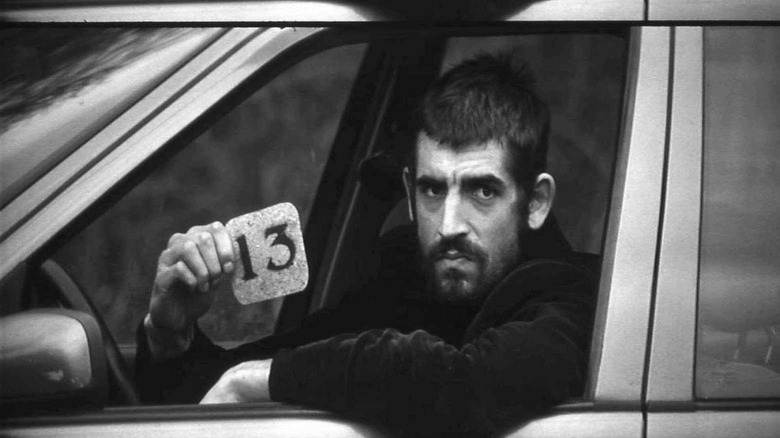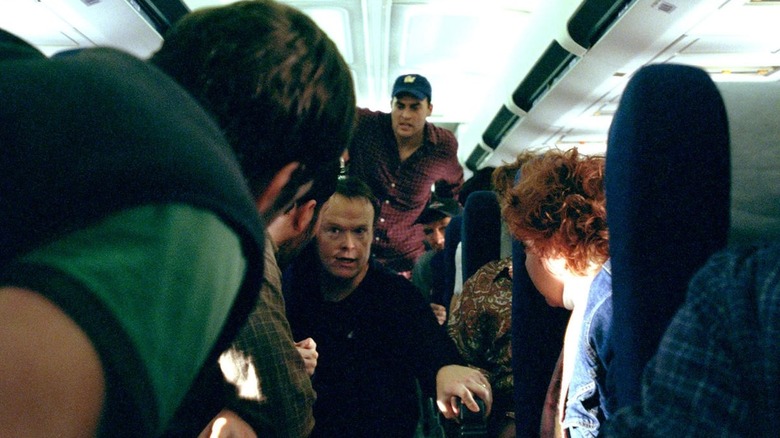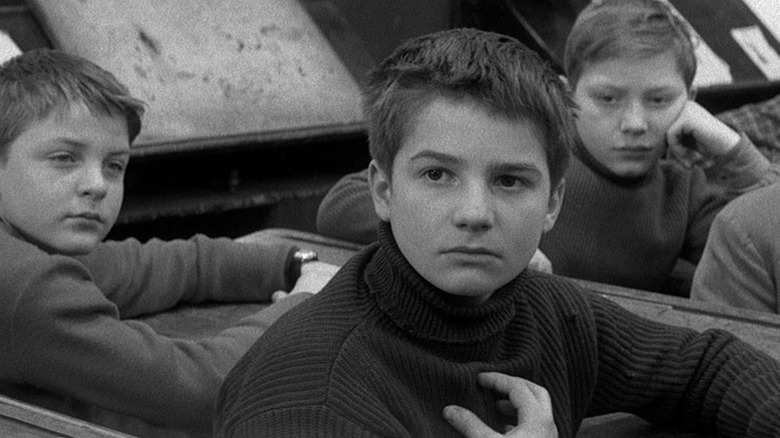Best Movies With A Number In The Title
We may receive a commission on purchases made from links.
The title of a film can be just as important as the content found within it. Some are judged by their name, while others have become memorable because of it. Numbers cardinal, ordinal and nominal have always had a special place in film titles, and have been found in them as far back as the 1900 British documentary "Noon Hour of 3000 Employees," and the dramatic 1911 Italian short, "Sixtus the Fifth."
Narrowing down the best movies with a number in the title is no easy feat, as tough choices had to be made (our deepest condolences to both Kurosawa's "Seven Samurai" and its remake, "The Magnificent Seven"), and rules had to be set, and followed, mainly: 1) no titles with numbers that represent a sequel or subsequent film, no matter how genius the title is, a la "2 Fast 2 Furious," and 2) no titles with a year, past, present, or future, with apologies to the best of them — Kubrick's "2001: A Space Odyssey."
Those are lists for another day. Today, let's stick with bringing to the surface the best of these not so hidden figures.
And one note for budding filmmakers — if you want to make a mark on your debut film, use a number in your title. If your film has got the goods, the numbered title certainly can't hurt. Just ask François Truffaut, Sidney Lumet, Darren Aronofsky, Géla Babluani and Neill Blomkamp.
One Day in September
The single day referred to in the title of Kevin Macdonald's 1999 documentary "One Day in September" was the 5th day of the ninth month of 1972, when the Munich massacre took place, and shattered the friendly and peaceful image of the Olympics forever.
The Summer Games of the XX Olympiad were the first to be held in Germany since the Nazi-saturated 1936 ones in Berlin. The motto was "Heitere Spiele ("The Cheerful Games"), and security on the grounds was purposely lax. At 4:30 a.m. on the 5th, the Palestinian terrorist group Black September took 11 Israeli athletes and coaches hostage, and in the process took the games hostage as well. The world was glued to their televisions to see how it all played out, and the unfolding tragic events are given a chilling and suspenseful retelling by Macdonald through archival footage, revealing interviews, and an excellent soundtrack.
The Michael Douglas-narrated doc took home Oscar gold at the 2000 Academy Awards, and an in-depth companion book by Simon Reeve was released the same year. The 2005 Steven Spielberg-directed film "Munich" examined the Israeli covert operational response that followed the massacre.
One Flew Over The Cuckoo's Nest
Writer Ken Kesey plucked the name of his acclaimed 1962 novel "One Flew Over the Cuckoo's Nest," about patients in an Oregon psychiatric hospital and the staff who "help" them, from the nursery rhyme "Vintery, Mintery, Cutery, Corn." A year after the book's release it headed to Broadway, where the play adapted by Dale Wasserman from the novel starred Kirk Douglas as new patient Randle McMurphy, and co-starred Gene Wilder and William Daniels as fellow inmates.
Douglas secured the film rights to "Cuckoo," but couldn't get it off the ground — that is until his son Michael gave it a try. With Czech-American filmmaker Miloš Forman directing, and Jack Nicholson in the lead role, the 1975 film became just the second film to win all five major Academy Awards. While "Cuckoo" made the elder Douglas "more money" than any film he acted in, it was "one of the biggest disappointments of my life," and he "would gladly give back every cent if I could have played that role at 70 years old."
The Lord of the Rings: The Two Towers
J.R.R. Tolkien's "The Lord of the Rings" was actually six books published in three volumes. The middle volumes, called "The Two Towers," had "actually no real link between them," and in letters to publisher Rayner Unwin, Tolkien expressed, "I am not at all happy about the title," and initially let the two (out of a possible five to choose from) towers' identity be "ambiguous." In the final pages of the first volume, "The Fellowship of the Ring," the publishers spelled out which towers are highlighted in the follow-up volume — Orthanc and Minas Morgul, shown in a book cover illustration created by Tolkien himself.
Initially, Miramax had asked Peter Jackson to make only two movies out of the three volumes, but it turned into a trilogy when it moved forward with New Line Cinema. "The Two Towers" had to be reworked as a middle chapter to connect the other two films, and in the process, the towers' identities were changed to Orthanc and Barad-dûr to better suit the film's plot.
The "Two Towers" turned out to be the highest-rated film of the "LOTR" trilogy by critics, while the incredible motion-capture work of Andy Serkis as the CGI character Gollum and the intense 40-minute Battle at Helm's Deep helped it to become the highest grossing film of 2002. "Towers" received six Academy Award nominations, including Best Picture, and won two. It also contains the scene (which he didn't direct) that Jackson called his favorite of the trilogy.
The Three Caballeros
With fascism on the rise in 1941, the United States enlisted Hollywood to help promote the American way of life at home and abroad. As a part of their "Good Neighbor" policy, they sent Walt Disney and others on a goodwill tour of Latin America. When Disney returned, he created several animated shorts and two feature films as a sort of propaganda olive branch to our neighbors to the south. The first feature was 1942's "Saludos Amigos" ("Hello Friends"), which featured American icon Donald Duck and introduced the Brazilian bird character José Carioca. Two years later, those two teamed up with a third bird, Mexican Panchito Pistoles, for the 7th full length Disney feature, "The Three Caballeros."
"Caballeros" was one of the first feature films to blend animation and live action in the same frame. It was a painstaking technical feat at the time, using rear process projection that put singers, dancers and actors behind the animation. The success of this process led Disney to plan making "Cinderella" and "Alice in Wonderland" in a similar fashion, although both were ultimately made in full animation.
The three main birds share the screen with humans Aurora "sister of Carmen" Miranda, Dora Luz, and Carmen Molina, as well as animated characters like the Aracuan Bird and Pablo the penguin. Nominated for Best Musical Score and Best Sound Recording at the 1946 Academy Awards, the songs of the film were so beloved that they have been covered by the likes of Bing Crosby, The Andrews Sisters, Dionne Warwick and Plácido Domingo.
The Third Man
"Cheap novelettes" writer Holly Martins (Joseph Cotten) is invited with the prospects of work to Vienna, at the behest of his old friend Harry Lime (Cotten's old friend Orson Welles). However, when Martins arrives, he is welcomed with the news of his friend's recent passing. Martins begins to investigate how he died, and the porter of Lime's building tells him about a few men who carried his body. Two were identified, but "there was a third man." As the plot thickens in the script by Welles, Graham Greene and director Carol Reed, the more intriguing the life and death of Harry Lime becomes. Later on, Martins is asked if he's working on a book, to which he replies, "Yes, it's a murder story, based on fact. It's called 'The Third Man.'"
Shot on location in a divided, postwar Vienna, the 1949 noir picture beautifully takes us to very dark and shadowy corners of the Austrian capital, and finishes up with two memorable sequences at the city's famed giant Ferris wheel and a cemetery (where Beethoven, Schubert, Brahms, and, uh, rocker Falco are all laid to rest). "The Third Man" is not only one of the best ordinal-numbered films, but also one that employs a zither-filled theme.
The film also inspired the name of two of rock star Jack White's companies, Third Man Upholstery and Third Man Records.
π (Pi)
π (pi) is the 16th letter of the Greek alphabet, and is the symbol used in math to denote the ratio of the circumference of a circle to its diameter. It is also the title of the 1998 debut feature film by Darren Aronofsky that won him the Best Director prize at that year's Sundance Film Festival. The protagonist of "π" is a maddened mathematician named Maximillian Cohen (played by Aronofsky's Harvard buddy Sean Gullette) who lives a solitary existence defined by his belief that everything in nature and life can be "represented and understood" through mathematics and numerical patterns.
These numerical patterns both haunt and motivate Max, whose ultimate endgame is to find the pattern in the chaos of the stock market. This leads him down a rabbit hole filled with both pushy Wall Streeters and practitioners of Kabbalah, with his teacher Sol (Mark Margolis) warning him to not dig so deep. The "cyberpunk" film had a budget of $60,000, and Aronofsky gets more out of less in this "mystical math" journey that ends up being a search for a higher power. In an interview with Peter T. Chattaway, he spoke of the film's major theme of finding the "order beneath the chaos," and specifically of π itself, sounding a lot like his lead character, "What is in that infinite string of numbers? Is the name of God there? Is it the universe's DNA?" He presents the ideas in an incredible fashion, and lets the viewer calculate their own answers, even long after they've left the theater.
District 9
District Six was an area within Cape Town, South Africa, where many different races and religions once lived together. That is until 1966, when the apartheid regime came knocking and declared the area "whites only," displacing more than 60,000 of its residents and knocking down their homes and their lives in the process. This one dark chapter of the country's very dark history served as inspiration for Neill Blomkamp's 2009 debut feature: a parable about segregated aliens, where they were confined to and where they are being relocated from — the internment camp called "District 9."
"District 9" is an expansion of Blomkamp's documentary-style 2006 short film "Alive in Joburg," and was the project he and Peter Jackson moved forward with after their adaptation of the video game "Halo" fell apart. Both starred actor Sharlto Copley. With shades of the humanity of "E.T." and wizardry of "Starship Troopers," Blomkamp's film does an excellent job playing with audience perceptions, while relaying a message of finding similarities in our differences. "District 9" grossed over $210 million worldwide and was feted with four Academy Award nominations, including Best Picture and (rightfully so) Visual Effects. After years of speculation, "District 10" is currently in the works.
The Ten Commandments
Spoiler alert: In one of the final scenes of Cecil B. DeMille's classic 1956 Biblical epic about the Jews' exodus from Egyptian slavery, God presents prophet Moses with two stone tablets, containing laws outlining the principles and ethics to be followed by his followers — the Ten Commandments (although Mel Brooks would later lead us to believe there were originally Fifteen Commandments).
DeMille directed a silent version of the story with the same title in 1923 (set pieces were unearthed in an archeological dig a century later), but his 1956 version that starred a cavalcade of stars (Charlton Heston, Anne Baxter, Yul Brynner, and tens of thousands of extras and animals) became one of the more seminal, if not over-the-top and melodramatic, works in the sword and-sandal genre. It was nominated for seven Academy Awards and won one — the parting of the Red Sea alone was worthy of a statue for Best Visual Effects.
The film continues to find new fans, generation after generation, ever since the ABC network started airing it on TV in 1973, and became a staple of Easter/Passover holiday viewings (except for 1999). On TV, the 3-hour-and-40-minute spectacle runs an hour longer, and is a commitment almost harder to obey than all Ten of the Commandments combined.
12 Angry Men
Writer Reginald Rose's first time serving on a jury was for a New York court case involving manslaughter. He was particularly impressed by how he and his fellow jurors would have "the absolute finality of the decision" on the case. Excited by this role, he later admitted that he "probably was unbearable to the eleven other jurors." He turned his experience into a one hour teleplay — "12 Angry Men" — that aired live on CBS in 1954. After one of his sons watched it, he told his father, "Boy, were they angry!"
Three years later, Rose adapted his own teleplay into a screenplay that was directed by Sidney Lumet (his first feature-length film), and starred heavyweights Henry Fonda, Jack Warden, E.G. Marshall, Jack Klugman and Lee J. Cobb, the latter the angriest of all the (nameless) men. The film's story unfolds in continuous real time (shot out of order), and mostly takes place in the jury room, as Juror 8 tries to leave the door open for reasonable doubt, and convince the other 11 of the same, with a lot of yelling and sweating along the way.
"12 Angry Men" was nominated for Best Picture, Director and Adapted Screenplay, and went on to become a hit play on Broadway and the West End. There was even a 1997 made-for-TV remake directed by William Friedkin, with its own equally impressive (and angry) cast.
12 Monkeys
Screenwriters David Webb Peoples ("Blade Runner," "Unforgiven") and wife Janet were tasked with writing a remake of Chris Marker's 1962 time-traveling, nuclear holocaust short film "La Jetée," but felt James Cameron's "Terminator" saga accomplished that task rather perfectly. Instead, they used Marker's film as inspiration and wrote the "12 Monkeys" script, which would eventually be directed by the visionary Terry Gilliam, who added his own "quirkiness" to the project. In the film, a virus kills off 99% of humanity in 1996, forcing the survivors to live underground. Scientists from 2035 want a cure to the disease, and send a prisoner named James Cole (Bruce Willis) into the past to investigate an extremist animal activist group that may have been the source of the outbreak, the "Army of the 12 Monkeys" (the Peoples patterned the "Army" after the People for the Ethical Treatment of Animals).
Gilliam told Charlie Rose that "12 Monkeys" was a film about "the perception of reality," adding, "It's a way of looking at where we are now. Look at what the world is. What it isn't." Following Cole as he jumps back and forth through time, finding dead ends, MacGuffins, Brad Pitt in perhaps his finest role ever (which earned him his first Academy Award nomination), and his life in an endless loop is a lot to digest in just one viewing. The initial test screenings were disastrous, but Gilliam stuck to his guns, didn't change a thing and was rewarded with a surprise hit, which ended up being the top grossing film of his career.
13 Tzameti
A young Georgian immigrant named Sébastien (George Babluani) is looking to provide money for his family in need, in their newly adopted French homeland. When a temp job employer dies before paying him, Sébastien steals a letter from the deceased that contains mysterious, yet enticing prospects for riches. Following through on the letter's instructions will turn out to be more than he bargained for. Sébastien enters an underground world where gamblers line up to take action on other fortune seekers who play a multi-round game of Russian Roulette (it makes "The Deer Hunter" look like child's play), with the last man left alive cashing in. Each contestant is assigned a number, and Sébastien gets stuck with lucky 13 (in the Georgian language, Tzameti/ცამეტი is 13).
"13 Tzameti" was directed by the star's brother Géla. The latter's extremely intense, endlessly gripping 2005 debut feature was shot in glorious black and white, as he said it "removes one realism and replaces it with another." The film won top prizes at Sundance, Venice and various other film festivals around the globe.
Shortly after the film's release, Hollywood snapped up Babluani and had him remake his own movie, but dropped the "Tzameti" from the title and shot it in color. While the all-star tough guy cast is a dream team on paper — Jason Statham, Ray Winstone, 50 Cent, Mickey Rourke, Michael Shannon, Ben Gazzara, Alexander Skarsgård — the resulting movie didn't translate quite as well, and was a critical and box office disappointment.
United 93
On September 11, 2001, terrorists hijacked four planes with the horrific goal of using them as weapons to destroy iconic American buildings. Three of the planes succeeded in their mission, two of them hitting and destroying both of the World Trade Centers towers, with the third striking the Pentagon. The fourth plane, United Airlines flight #93, was to have targeted either the U.S. Capitol or perhaps even the White House. However, the passengers on flight #93 determined together to not let their hijacked plane succeed in whatever its mission was. They did thwart the terrorists, although the plane crashed in Shanksville, Pennsylvania, killing everyone onboard.
With the support of some of the victims' family members, Paul Greengrass created a harrowing real-time retelling of the events in 2006's "United 93." It was the first feature film to capture any of the day's events from 9/11, and to this day, it is perhaps one of the finest made about them. While Greengrass had to take some artistic licenses in order to fill in the gaps to tell the whole story, he told EW, "You can't know every last detail," adding, "It's about which one of us hasn't looked or thought about that event and wondered what it must have been like, or wondered how might we have behaved in that situation." The director and his editors were rewarded with Oscar nominations, but most importantly, the victims' families appreciated the film, with one saying, "It was both excruciating and beautiful at the same time."
Les Quatre Cents Coups (The 400 Blows)
François Truffaut was a critic for the pioneering film magazine "Cahiers du Cinema," and true to his occupation, was critical of others' work. He and his fellow writers weren't satisfied with the old guard's traditionalist ways of filmmaking, so they took up the task themselves and ushered in a "New Wave” of French cinema. Truffaut's 1959 debut was the semi-autobiographical film "Les Quatre Cents Coups," which is a take on the French idiom "faire les quatre cents coups," meaning "to raise hell." When it was renamed for the American market, the distributors couldn't settle on how to properly translate the title into English, so a literal one was used, and it became "The 400 Blows" forevermore.
Truffaut channeled his own childhood experiences of feeling unloved, truancy and passion for cinema into the character of Antoine Doinel (Jean-Pierre Léaud). The film's honesty and experimental nature won it universal acclaim, the Best Director prize at the Cannes and a Best Screenplay Oscar nod. It drew such favorable praise from French luminaries Henri-Georges Clouzot and Jean Cocteau that they used their pull quotes in the film's trailer.
It's fitting that the final frame of "The 400 Blows" left for an open ending, as Truffaut expanded on Doinel's life in a "cycle" of four subsequent films, the short "Antoine and Colette," and features "Stolen Kisses," "Bed and Board," and "Love on the Run," all starring Léaud.
